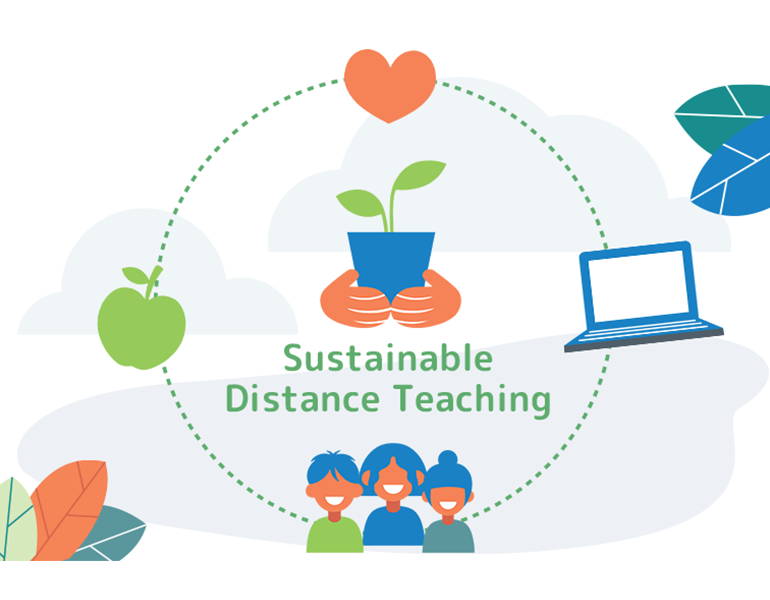
After taking the time-consuming and often awkward steps to bring our classes online, distance learning and remote teaching have become our ‘new normal’.
However, if we don’t establish what normal means, we’re at risk of burning out — and fast.
Our new normal has to be sustainable. By reflecting on what has worked, leaving behind what hasn’t, and choosing how we want to move forward, we will provide our students with the best education in a challenging time, and give ourselves the respite we need to keep our wellbeing in check.
Here’s how you can start setting sustainable distance learning and remote teaching practices today:
Put boundaries around your time
Your digital classroom is only a few clicks away, and three parent emails come through in the time it takes to prepare dinner. Forget the lax ‘working from home’ lifestyles others are touting on social media – you’re working harder than ever.
But teaching from home shouldn’t mean teaching around the clock. A sustainable work-life balance is vital to maintain the energy and perspective distance teaching requires.
Adhere to realistic and clearly defined working hours. Be transparent about your availability with parents and students so that they know when you are contactable and schedule in regular breaks. Don’t feel an obligation to be ‘on-call’. Your students will learn more effectively with the predictability of set teaching times and parents will have the benefit of your full attention during the working day.
Resist the urge to cram your off-hours full of planning and prepping too. Use the time to stay connected, exercise, do things you enjoy, and unwind without thinking about teaching. You’ll be better placed to jump back into it the next day with fresh eyes.
Refine your online learning platform
Narrow down the ten different online learning tools you’ve been juggling for the past month and refine them into a single, effective online learning platform. Your students won’t have to bounce around the web with five different logins each time you assign learning material and using it will become a familiar routine.
Get to know your chosen online teaching tools on a deeper level. Watch YouTube tutorials and consult online resources to find out how you can get the most out of them. The keys to that dynamic online discussion or collaborative activity you are seeking might be right there in your LMS or EdTech program — you just need to know where to look.
Now is also the time to assess any gaps in your platform’s capabilities. Does it enable you to deliver homework, differentiated learning, and assessments? Does it allow you to track student usage and coordinate collaborative activity? If not, supplement your learning platform with an EdTech solution to give the flexibility you need.
Implement lean teaching
Lean teaching involves cutting back on time-consuming strategies and replacing them with more efficient ones that get the same results (or better). Try the following lean teaching strategies to work smarter instead of harder:
- Replace half-hour, edited video lessons with short instructional clips that hold students’ attention and take less time to prepare.
- Record feedback as a voice message instead of painstakingly typing it out. It takes less time and your voice makes it more personal and meaningful.
- Outsource homework to an EdTech program which assigns it automatically.
- Create a friendly FAQ sheet for parents to avoid answering the same questions over again.
- Replace regular short assessments with longer projects.
- Use peer-assessment and self-reflection for student feedback in formative tasks.
Realistically adjust your plans
The plans you had at the start of the school year will look positively utopian by now, so scale them back. Work with your colleagues to agree on what learning outcomes are achievable under the current circumstances and then backward plan through the steps you will take to make this happen.
Before you trim down the curriculum, adjust your assessments and modes of delivery first. For example, you could achieve the same learning outcomes by replacing a studied text with an eBook or replacing teacher-led tasks with more open-ended, explorative projects.
If you decide certain learning outcomes simply aren’t realistic with students learning from home, start building prior knowledge to make these concepts more accessible when they do return to school. Pave the way for critical analysis of a text by having students share bullet-pointed ideas, or task them with building a fort to start considering area and measurement. The process is gradual, but the end learning remains the same.
Work with parents
Creating a productive parent-teacher partnership will make distance learning more sustainable for everyone involved. You’ll have parent assistance in supervising home learning, they’ll be confident that you’re in control and your students will benefit from the learning support on both sides.
Brief parents on the plan for home learning. They should know what material is going to be covered, where it can be accessed, and how to contact you if help is required. Sending this information out as soon as possible will quell any parental fears that student learning has been halted or left up to them entirely.
Provide strategies that parents can use to support home learning as well. Beyond supervising their child, there is a whole host of activities parents can use to engage their child and promote learning at home. Compile these into a helpful list and email them to parents seeking guidance.
Remember: You cannot expect parents to formally teach the curriculum content for you. Most will have busy schedules and limited teaching experience, so keep your suggestions achievable.
Share resources and knowledge
Exchange worksheets, web resources, and activity ideas over email. You can also take turns creating and sharing flipped video lessons with colleagues teaching the same curriculum. It’s far less time-consuming and your students will be engaged when they see a different face appear on their screens.
Get the benefit of others’ success stories and tips too with regular staff catch-ups on Skype or Zoom, or by joining a teachers’ Facebook group. Besides actionable advice, you’ll also be preserving the connections we all need during this time of relative isolation.










